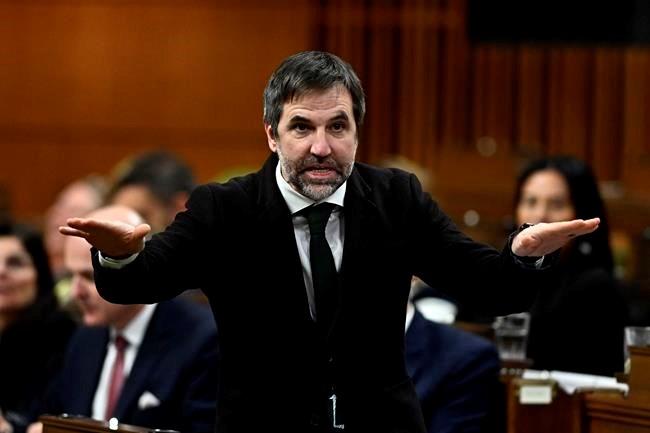OTTAWA ŌĆö The Liberal government had to delay its long-promised regulations to cap emissions from oil and gas production in sa╣·╝╩┤½├Į because of two recent court decisions forcing Ottawa to tread more carefully on climate policy affecting provinces, Environment Minister Steven Guilbeault said Friday.
Guilbeault is in Dubai for the annual United Nations climate conference, this year known as COP28. He has said he expects sa╣·╝╩┤½├Į to publish its framework for the cap while at the global meeting, but not the regulations themselves.
Oil and gas production accounts for more than one-quarter of sa╣·╝╩┤½├Į's total greenhouse-gas emissions, which have grown significantly since 2005. While emissions from natural gas and conventional oil production have fallen over that period, oilsands emissions are up 142 per cent.
Guilbeault has been clear that without substantial cuts to emissions in the oilpatch, sa╣·╝╩┤½├Į cannot reach its national 2030 climate target to reduce emissions by 40 to 45 per cent below 2005 levels.
Earlier this year, Guilbeault said the regulations for the cap ŌĆö first promised in the 2021 election ŌĆö were coming together slowly because they are extremely complicated. He has noted sa╣·╝╩┤½├Į is the only major oil and gas producer contemplating such a policy.
On Friday, he told reporters in a news conference from Dubai that recent court rulings on the Liberal government's environment policy added to that complexity.
The first was a Supreme Court decision that said the new federal law governing environmental impact assessments stepped into provincial jurisdiction by applying to some projects that should have been outside Ottawa's control.
The second was a Federal Court decision that struck down Environment sa╣·╝╩┤½├Į's designation of all plastic manufactured items as "toxic." The court said the category of plastic manufactured items was too broad for a single designation. The decision also touched on some federal-provincial distribution of powers.
"We were being told by our tribunals that the federal government can certainly intervene when it comes to matters of pollution, and including climate pollution, but that we have to be very careful not to impede on provincial jurisdictions," Guilbeault said.
"(That) has meant that we have to make sure that our regulation does exactly that, that it tackles pollution without infringing on the provincial jurisdiction. And that has meant that it has taken a little bit more time than maybe we have initially anticipated."
Guilbeault said Friday he had hoped to have it all done earlier.
At the COP27 talks in Egypt last year, Guilbeault had said the draft regulations were expected in the spring of 2023. He said the final versions would come by the end of this year.
Since that time, the government has shifted its language. It started saying a "framework" for the cap would come by the end of this year. Guilbeault said Friday this would outline what the emissions caps will be set at and how industry can meet them.
The draft regulations are now not expected till 2024. Guilbeault said in September that it would then take at least another year after the draft is published for the cap begins to apply.
The Liberals' 2021 election platform promised to cap emissions from oil and gas production at "current" levels but they have never specified where that cap would start or how low it has to go.
Last year's emissions-reduction plan, which is the latest road map to meet sa╣·╝╩┤½├Į's 2030 targets, calls for oil and gas emissions to fall 42 per cent compared to 2021 levels.
But the government said at the time that was not necessarily the cap.
The industry has repeatedly said it cannot meet that target without cutting production, and Alberta Premier Danielle Smith has said she will challenge any emissions cap on the sector.
Smith and Guilbeault have clashed repeatedly in recent months but the two are set to meet in person while they are both in Dubai for COP28.┬Ā
Guilbeault said Friday that regulations to cut methane emissions from the oil and gas sector are also likely to come during COP28. sa╣·╝╩┤½├Į has existing methane regulations that call for a 40 to 45 per cent cut in methane from oil and gas production by 2030, but intends to increase that to 75 per cent.
He said that policy alone will play a huge role in cutting overall oil and gas emissions.
"Collectively, globally, if we are ambitious in our efforts to tackle methane emissions, we could shave off almost 1 C of potential warming by 2100," he said. "That's massive. And we have the technology to do that and there is a real global push to do that."
This report by The Canadian Press was first published Dec. 1, 2023.
Mia Rabson, The Canadian Press
Note to readers: This is a corrected story. An earlier version carried a headline that referred to multiple Supreme Court decisions.



